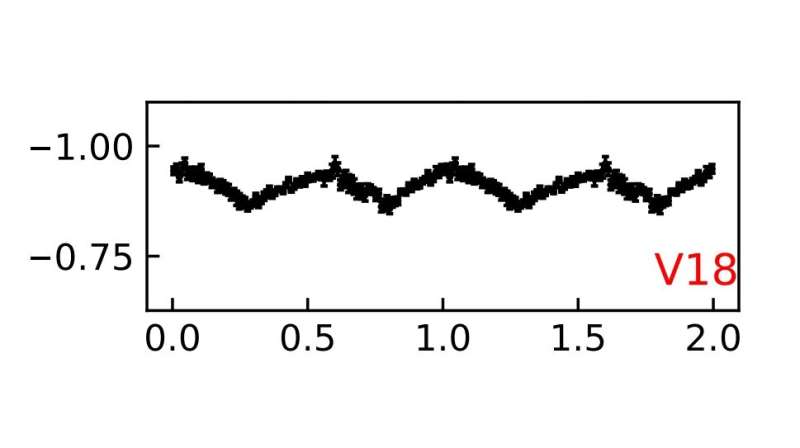May 4, 2023 report
This article has been reviewed according to Science X's editorial process and policies. Editors have highlighted the following attributes while ensuring the content's credibility:
fact-checked
preprint
trusted source
proofread
New variable star detected by Chinese astronomers

Using the Nanshan One-meter Wide-field Telescope (NOWT), astronomers from China have performed a photometric survey of the old open cluster NGC 188. In result, they identified many variable stars, one of which was detected for the first time. The finding was reported April 25 on the arXiv pre-print repository.
Detecting and studying variable stars could offer important hints into aspects of stellar structure and evolution. Investigation of variables could be also helpful for a better understanding of the distance scale of the universe.
Located some 5,400 light years away in the constellation Cepheus, NGC 188 (also known as Caldwell 1) is a well-studied Galactic open cluster (OC) estimated to be about 6.8 billion years old. It is one of the most ancient, rich OCs in the Milky Way galaxy and is known to host dozens of variable stars.
A group of researchers led by Fang-Fang Song of the Xinjiang Astronomical Observatory in China, has conducted another study of NGC 188, identifying 25 variable stars, out of which one turned out to be new detection. They employed NOWT to carry out the charge-coupled device (CCD) photometric survey of this cluster.
"In this paper, we have presented the time-series V-band photometric survey of the open cluster NGC 188, with particular emphasis on variable stars," the researchers wrote.
All in all, the study detected 25 variable stars in a 55 × 45 arcmin2 (corresponding to 2,900 × 2,400 pixels) field of view around NGC 188. The variables received designations V1 to V25, and the results suggest that 16 variables are cluster members while the remaining stars belong to the field star population.
The newly discovered star, designated V18, is a periodic variable with a period of approximately 0.317 days. The results indicate that it is a field star about 6,000 light years away, with an effective temperature of 6,116 K.
According to the authors of the paper, the collected data suggest that V18 is most likely a W Ursae Majoris, W UMa (EW) for short, system. In general, EWs are eclipsing binary variable stars—close binaries of spectral types F, G, or K that share a common envelope of material and are in contact with one another. Besides V18, there are 11 other EWs in the sample of 25 identified variables—from V1 to V11.
The data obtained by Song's team also allowed them to reclassify one previously known variable—V21 (other designation V0769 Cep). NOWT observations show that V21 is likely an EA-type eclipsing binary, given that a 0.5 magnitude eclipse was detected in its light curve, rather than BY Draconis type variable—as was suggested by previous studies.
More information: Fang-Fang Song et al, Variable stars detection in the field of open cluster NGC 188, arXiv (2023). DOI: 10.48550/arxiv.2304.12738
Journal information: arXiv
© 2023 Science X Network





















